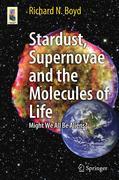
Stardust, supernovae and the molecules of life: might we all be aliens?
Boyd, Richard N.
Where were the amino acids, the molecules of life, created: perhaps in a lightning storm in the early Earth, or perhaps elsewhere in the cosmos? This book argues that at least some of them must have been produced in the cosmos, and that the fact that the Earthly amino acids have a specific handedness provides an important clue for that explanation. The book discusses several models thatpurport to explain the handedness, ultimately proposing a new explanation that involves cosmic processing of the amino acids produced in space. The book provides a tour for laypersons that includes a definition of life, the Big Bang,stellar nucleosynthesis, the electromagnetic spectrum, molecules, and supernovae and the particles they produce. Gives a detailed description of handedness of the amino acids, a critical element in understanding their origin, as well as a plausible model by which their handedness could have been produced. Relates everything to basic physicalproperties and forces of nature, written in lay person language, which no other book on the molecules of life does. Offers discussions of some fascinating aspects of modern physics that impinge on the question of amino acid origin, e.g., the big bang, neutrino physics, and supernovae INDICE: Table of Contents. Preface. Chapter 1: Introduction. 1.1: In the Beginning. 1.2: What is 'Life?'. 1.3: The Miller Urey Experiment. 1.4: General Background and Definitions. Chapter 2: What is the Origin of the Lightest Elements. 2.1: The Big Bang. 2.2: The Supernova Cosmology Project. 2.3: The Wilkinson Microwave Anisotropy Probe. 2.4: Olber's Paradox. 2.5: Big Bang Nucleosynthesis - BBN. Chapter 3: What is the Origin of the Rest of the Elements?. 3.1: Introduction to Stellar Nucleosynthesis. 3.2.1: Hydrogen Burning. 3.2.2: Helium Burning. 3.2.3: Subsequent Burning Stages. 3.3: After Stellar Burning. 3.3.1: Creating a Core-Collapse Supernova Explosion. 3.3.2: Synthesizing the Heavy Elements. 3.3.3: White Dwarfs. 3.3.4: Type Ia Supernovae. Chapter 4: Creation of Molecules in the Interstellar Medium. 4.1: The Electromagnetic Spectrum. 4.2: Detecting Photons of Different Energies. 4.3: Secrets from Meteorites. 4.4:Mining the Comets. 4.5: The Next Huge Step - Forming Life from the Molecules Delivered to Earth. Chapter 5: Amino Acids and Chirality. 5.1: A Primer on Amino Acids. 5.2: Chirality and Polarization. 5.3: Relating Optical and MolecularChirality. 5.3.1: Chiral Selection. 5.3.2: A Little Atomic Physics and Some Very Basic Quantum Mechanics. 5.4: The Other Molecules of Life. Chapter 6: How Have Scientists Explained the Amino Acid Chirality?. 6.1: Models that Produce Chirality. 6.1.1: Chiral Selection via Circularly Polarized Sunlight. 6.1.2: Chiral Selection via Circularly Polarized Sunlight. 6.1.3: Chiral Selection viathe Weak Interaction. 6.1.4: Chiral Selection via Chemical Selection in Clay.6.2: Amplification via Chemical Catalysis. 6.3: Laboratory Experiments and Theoretical Developments. 6.4: Terrestrial Amplification. 6.5: Concluding Remarks on Amplification.- Chapter 7: What Happens to the Amino Acids When the Supernova Explodes?. 7.1: The Supernova. 7.2: The Neutrino Story. 7.3: Interactions of Neutrinos with 14N. 7.4: Relating the 14 N Spin to the Molecular Chirality. 7.5: The Supernova Progenitor Star. Chapter 8: Spreading Chirality Throughout the Galaxy and Throughout the Earth. 8.1: Might Supernovae Process All the Amino Acids in the Galaxy?. 8.2: Spreading Molecules and Enantiomerism Throughout the Galaxy. 8.2.1: Cosmic Amplification. 8.2.2: Cosmic Amplification. 8.2.2: Galactic Mixing. 8.2.3: Planetary Amplification. 8.3: Testing the Models ofAmino Acid Chirality. 8.4: The Impact of Amino Acid Chirality on Questions ofthe Origin of Life in the Universe. Chapter 9: What About the Rest of the Universe?. 9.1: Are We Alone?. 9.2: Extremophiles on Earth. 9.3: And From Outer Space?. Glossary. Index.
- ISBN: 978-1-4614-1331-8
- Editorial: Springer New York
- Encuadernacion: Rústica
- Páginas: 230
- Fecha Publicación: 16/01/2012
- Nº Volúmenes: 1
- Idioma: Inglés
